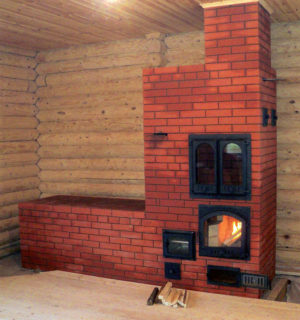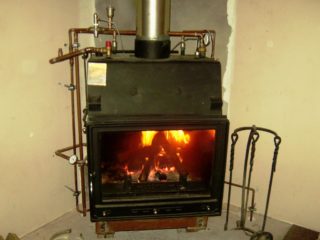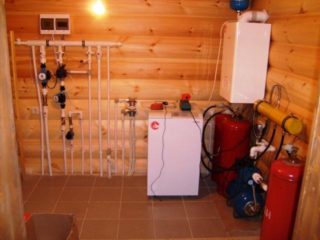The installation of boiler equipment gives owners of personal estates and country houses a number of advantages, including the ability to choose the type of “working” fuel. But most modern energy carriers, over time, become more expensive and become "unbearable" even for well-off families. With rising prices for them, the consumer thinks about how to equip heating without gas and other traditional sources, hoping to save considerable funds.
What is an alternative heat source?
Among the known types of alternative energy sources and in terms of their suitability for heating in a private house without gas, the following varieties stand out:
- devices working in conjunction with existing energy converters - as an addition to a solid fuel boiler, for example;
- complexes replacing a gas or electric unit.
The first of them are not able to heat the house, as required.
The main part of the heat is generated by the gas boiler, and additional funds in accordance with the standard technological map (TTK) make up the need for it in peak loads or in the off-season.
The second category is heat sources that produce enough energy to completely heat the building without the help of a boiler. It is customary to include the following equipment:
- a heat pump, considered one of the most economical sources of energy for heating;
- air pumps;
- soil collector installations - they are often called "geothermal";
- for the southern regions - the use of solar energy.
For the operation of these near-autonomous systems to be successful, prerequisites will be required.
Gas-free heating equipment
When choosing the option of economical heating in a private house in which there is no gas, modern substitutes for these systems should be considered. The equipment that provides the user with cheap energy includes the following types:
- heat pumps;
- their air counterparts;
- soil (bio) and solar collectors;
- fireplaces equipped with a water circuit;
- pellet heaters;
- air conditioners.
A heat device is a device that runs on electricity and heats water by compressing freon with a special built-in compressor. The gas charged into the system is preheated from an economical source and, being under a pressure of 28 bar, increases its temperature from the initial 5-10 degrees several times. At the same time, it emits a significant amount of heat that can heat the coolant in the system to 50-60 degrees. It is considered the most profitable in terms of price-performance ratio.
Air heat units are cheaper and easier to install and are also able to completely replace a gas boiler, but at low street temperatures their performance drops sharply. To use them for heating a house becomes economically unprofitable. Most often, these units are used together with the boiler, and in the warm season they work autonomously.
Heat pumps powered by groundwater energy are considered a good substitute for a gas boiler because they are independent of street temperature. Their disadvantage is the high cost and long payback periods (at least 10 years).In addition, such a project will require a significant area of land in the country, on which the soil collector is being built. Solar analogues of these units are also attractive, but limited in application. Their value also does not suit everyone.
Fireplace structures with a water circuit for heating a house in the most economical way without gas are gaining more and more popularity among owners of suburban cottages and mansions. They are too complicated to arrange and require significant expenses from the owners. In addition, they can only be installed at the stage of construction of a residential building, since it is unprofitable and too troublesome to convert a finished fireplace to these needs. Using modern fuel briquettes or pellets in combination with a conventional solid fuel boiler unit is a great way to save on combustible materials. However, in this case, as in all previous options, the question arises of too high costs.
The essence of the work of split systems as heaters is to lower the temperature of air taken from the street in winter and its subsequent regeneration. Due to the resulting difference in temperature inside the apartment, heat is generated that goes to its heating. Air conditioners as heaters are a novelty in the technology of space heating, so it is very difficult to assess their effectiveness. It depends on many factors, including the temperature of the air outside the apartment, as well as the design power of the split system itself.
Options in the absence of electricity
If there is no gas and electricity at the same time, you can heat the house in the following ways:
- install a simple stove or solid fuel boiler integrated into the water supply system;
- use firewood, coal, fuel briquettes or pellets as an energy carrier;
- organize autonomous heating with liquefied propane stored in cylinders or gas tanks.
In the latter case, the source of heat is a conventional gas boiler or modern convectors that heat the room by shifting the air layers.
To obtain heat, it is allowed to use relatively cheap diesel fuel or waste oil by installing the appropriate equipment in the house.
Alternative heating equipment for an apartment

If you need to organize heating for a city apartment, you can ensure the economical use of infrared heaters or a heat air pump. In the southern regions, it is more convenient to use split systems. It is necessary to artificially isolate options for generating thermal energy that do not need to be connected to a household electrical network. These include:
- wood stoves (metal or brick), as well as fireplaces;
- solid fuel boilers with draft regulator, working on the principle of natural circulation;
- non-volatile floor boilers for liquefied gas connected to a gravity-fed system with water batteries (radiators).
Any attempt to independently create an independent heating system without connecting to the network ends in failure, since the control equipment is included in the set of any equipment. Without it, the reliability and safety of the units decreases sharply, which does not suit any responsible user.
Use of solid fuel in suburban homes
The following methods of organizing heating without gas are common:
- use of coal or firewood;
- the use of special briquettes compressed from biomass waste: sawdust, sunflower husk, straw, pine needles, etc .;
- burning solid fuel in furnaces and boilers specially equipped for this purpose.
The simplest heaters such as wood-burning stoves are designed for direct heating of indoor air. The second type of heating equipment is more complicated and includes additional heat exchange systems: radiators or underfloor heating. In addition, the installation of a heating system using a steel or cast-iron stove will cost the owner of the house much cheaper. For its installation and commissioning, you do not need to invite third-party specialists and masters, since all these operations are quite possible to do with your own hands.
Thanks to its use, it is possible to obtain the following advantages:
- a correctly installed brick oven heats many rooms at once, saving heat directly in the thickness of the walls;
- any of these sources is simultaneously applicable for cooking home-made food, as well as drying clothes.
The design of many simple stoves provides a water circuit mounted directly into the furnace and manufactured in the form of a tank or a coil. These heating elements are connected to heating radiators located in neighboring rooms.
According to construction standards, for the free circulation of the coolant, pipes of increased diameter, laid with a slight slope, will be required. An extreme measure to resolve the issue is to install a circulation pump in the system.







